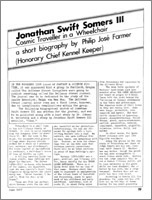|
|
Jonathan Swift Somers III: Cosmic Traveller in a Wheelchair |
|
A short biography by Philip José Farmer (Honorary Chief Kennel Keeper)
Copyright © 1977, Originally published in Scintillation 13, Volume 4, Number 2, June 1977, pages 19-24. Note about this reproduction: Punctuation, spelling and typographical errors have been corrected. Breaks in words and paragraphs indicate the original publication’s page breaks for reference purposes.
This article’s history was as noted in the Editor’s Note (written by Philip José Farmer). The Bellener Street Irregulars were a short-lived association established by Rick Bilyeu. |
Page 19
Editor’s note: In the November 1976 issue of Fantasy & Science Fiction, it was announced that a group in Portland, Oregon, called The Bellener Street Irregulars were going to publishing something called The Bellener Street Journal. The journal was to be dedicated to the study of the canine detective, Ralph von Wau Wau. The Bellener Street Journal never even saw a first issue, however, due to inexplicable complications within the group. The following biographical sketch of Jonathan Swift Somers III was written for the journal, and was to be published along with a lost story by Dr. Johann H. Weisstein and a story by Jonathan Swift Somers III entitled, “Jinx.” Petersburg is a small town in the mid-Illinois county of Menard. It lies inhilly country near the Sangamon River on state route 97. Not far away is New Salem, the reconstructed pioneer village where Abraham Lincoln worked for a while as a postmaster, surveyor and storekeeper. The state capital of Springfield is southeast, a half-hour’s drive of less if traffic is light. A hilltop cemetary holds two famous people, Anne Rutledge and Edgar Lee Masters. The former (1816-1835) is known only because of the legend, now disapproved, that she was Lincoln’s first love, tragically dying before she could marry him. “Bloom forever, O Republic, From the dust of my bosom!” These are from the epitaph which Masters wrote for her and are inscribed on her gravestone. Unfortunately, the man who chiseled the epitaph made a typo, driving Masters into a rage. We authors, who have suffered from so many typos, can sympathize with him. However, we have the advantage that we can make sure that reissues contain corrections. There will be no later editions in stone of Anne Rutledge’s epitaph. Masters (1869-1950) was a poet, novelist and literary critic, known chiefly for his Spoon River Anthology. There is a Spoon River area but no town of that name. Masters chose that name to represent an amalgamation of the actual towns of Lewistown and Petersburg, where he spent most of his childhood and early adulthood. Lewistown, also on route 97, is about forty miles from Petersburg but separated by the Illinois River. The free verse epitaphs of Masters’ best-known work were modeled after The Greek Anthology but based on people he’d known. These told the truth behind the flattering or laconic statements on the tombs and gravestones. The departed spoke of their lives as they had really been. Some were happy, productive, even creative and heroic. But most recite chronicles of hypocrisy, misery, misunderstanding, failed dreams, greed, narrow-mindedness, egotism, persecution, madness, connivance, cowardice, stupidity, injustice, sorrow, folly and murder. In other words, the Spoon River citizens were just like big-city residents. Among the graves in the cemetary of Petersburg are those of Judge Somers and his son, Jonathan Swift Somers II. Neither has any marker, though the grandson has made arrangements to erect stones above both. Masters has the judge complain that he was a famous Illinois jurist, yet he lies unhonored in his grave while the town drunkard, who is buried by his side, has a large monument. Masters does not explain how this came about. According to Somers III, his grandson, the judge and his wife were not on the best of terms during the ten years preceding |
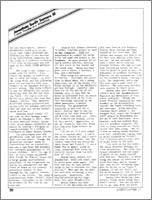
|
Page 20
the old man’s death. Somers’ grandmother would give no details, but others provided the information that it was because of an indiscretion committed by the judge in a cathouse in Peoria. (This city is mentioned now and then in the Spoon River Anthology.) The judge’s son, Somers II, sided with his father. This caused the mother to forbid her son to enter her house. In 1910 the judge died, and the following year the son and his wife were drowned in the Sangamon during a picnic outing. The widow refused to pay for monuments for either, insisting that she did not have the funds. Her son’s wife was buried in a family plot near New Goshen, Indiana. That Samantha Tincrowder Somers preferred not to lie with her husband indicates that she also had strong differences with him. Jonathan Swift Somers III was born in this unhappy atmosphere on January 6, 1910. This is also Sherlock Holmes’ birthdate, which Somers celebrates annually by sending a telegram of congratulations to a certain residence on Baker Street, London. The forty-three year old grandmother took the year old infant into her house. Though the gravestone incident seems to characterize her as vindictive, she was a very kind and probably too indulgent grandmother to the young Jonathan. Until the age of ten, he had a happy childhood. Even though the Somers’ house was a large gloomy mid-Victorian structure, it wad brightened for him by his grandmother and the books he found in the library. A precocious reader, he went through all the lighter volumes before he was eleven. The judge’s philosophical books, Fichte, Schopenhauer, Nietzsche, et al, would be mastered by the time he was eighteen. Despite his intense interest in books, Jonathan played as hard as any youngster. With his schoolmates he roamed the woody hills and swam and fished in the Sangamon. He gave promises of being a notable athlete, beating all his peers in the dashes and the broad jump. Among his many pets were a raven, a racoon, a fox and a bullsnake. Then infantile paralysis felled him. Treatment was primitive in those days, but a young physician, son of the Doctor Hill whose epitaph is in the Anthology, get him through. Jonathan came back out of the valley of the shadow, only to find that he would be paralyzed from the waist down for the rest of his life. This knowledge resulted in another paralysis, a mental freezing. His grandmother despaired of his mind for a while, fearing that he had retreated so far into himself he would never come back out. Jonathan himself now recalls little of this period. Apparently, it was so traumatic that even today his conscious mind refuses to touch it. “It was as if I were embedded in a crystal ball. I could see others around me, but I could not hear or touch them. And the crystal magnified and distorted their faces and figures. I was a human fly in amber, stuck in time, preserved from decay but isolated forever from the main flow of life.” Amanda Knapp Somers, his grandmother, would not admit that he would never walk again. She told him that he only needed faith in God to overcome his ‘disability.’ That was the one word she used when referring to his paralysis. Disability. She avoided mentioning his legs; they, too, were disabilities. Amanda Somers had been raised in the Episcopalian sect. She came from an old Virginia family whose fortune had been ruined by the Civil War. Her father had brought his family out to this area shortly after Appomattox. He had intended to stay only a short while with his younger brother, who had settled near Petersburg before the war. Then he meant to push on west, to homestead in northern California. However, he had sickened and died in his brother’s house, leaving a wife, two daughters and a son. The wife died a year later of cholera. The surviving children were adopted by their uncle. Amanda came into frequent contact with the fundamentalist Baptists and Methodists of this rural community. Though she never formally renounced her membership in the Episcopalian church, she began attending revival meetings, After marrying Jonathan Swift Somers I, she stopped this, since the ‘respectable’ people in Petersburg did not go to such functions. Now, however, with her husband dead and her grandson crippled, she went to every revival and faith healer that came along. She insisted on taking young Jonathan with her, undoubtedly hoping that he would suddenly be ‘saved,’ that a miracle would occur, that he would stand up and walk. This went on for two years. The child objected strongly to these procedures. The tense emotional atmosphere and the sense of guilt at not being ‘saved’ wore him out. Moreover, he hated being the center of attention at these meetings, and he always felt that he let everybody down when he failed to be ‘cured.’ Somehow, it was his fault, not the faith healer’s, that he could not rid himself of his paralysis. During this troubling time, several things saved young Jonathan’s reason. One was his ability to get away from the world |
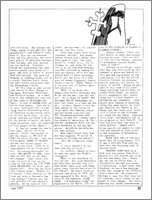
Illustration: William Rotsler |
Page 21
into his books. The library was large, since it included both his grandfather’s and father’s books. Much of this was too advanced even for his precocity, but there were plenty of adventure and mystery volumes, and even fantasy was not lacking. Moreover, though his grandmother had some narrow-minded ideas about religion, she made no effort to supervise his reading. She gave him freedom in ordering books, and as a result Jonathan had a larger and more varied collection than the Petersburg library. At this time he came across John Carter of Mars, Tarzan of the Apes, Professor Challenger and Sherlock Holmes. In a short time he had ordered and read all of the works of Burroughs and Doyle. A copy of Before Adam led him to Jack London. This writer, in turn, introduced him to something besides fascinating tales of adventure in the frozen north or the hot sound seas. He gave young Jonathan his first look into the depths of social and political injustice, into the miseries of “the people of the abyss.” It was not enough for him to read about far-off exciting places. Unable immediately to get the sequel to The Gods of Mars, he wrote his own. This was titled Dejah Thoris of Barsoom and was one-hundred pages, or about 20,000 words, quite an accomplishment for an eleven-year old. On reading Burroughs’ sequel, The Warlord of Mars, Jonathan decided that he had been out-classed. Years later, however, he used an idea in his story as the basis for The Ivory Gates of Barsoom, his first published novel. This was his first John Clayter story. Clayter is, of course, a name composed of the first syllable of Tarzan’s English surname (Clayton) and the last syllable of John Carter’s surname. At the time of this novel, the spaceman John Clayter has not lost his limbs. More than books saved young Jonathan, however. His grandmother brought him a German Shepherd (police) pup. The child loved it, talked to it, fed it, brushed it, and threw the ball for it in the big backyard. Jonathan insisted on naming the male pup Fenris, after the monstrous wolf in Norse mythology. Fenris was the first of a long line of German Shepherds, Somers’ favorite breed. Today, Fenris IX, a two-year old, is Somers’ devoted companion. There is no doubt that Somers modeled his fictional dog, Ralph von Wau Wau, upon his own pet. Or is there no doubt? The Bellener Street Irregulars insist that there is a real von Wau Wau. In fact, Somers is not the real author of the series of tales about this Hamburg police dog who became a private eye. The Irregulars maintain that Somers is only the literary agent for Johann H. Weisstein, Dr. Med., and for Cordwainer Bird, the two main narrators in the Wau Wau series. Weisstein and Bird are the real authors. When asked about this, Somers only replied, “I am not at liberty to discuss the matter.” “Are the Irregulars wrong then?” “I would hesitate to say that they are in error.” So, perhaps, Somers is really only the agent for Ralph’s colleagues. There is one objection to this belief. How could Weisstein and Bird have written true stories about their life with Ralph since these stories took place in the future? The dog’s first adventure took place in 1978, yet this appeared in the March 1931 issue of the magazine, Outré Tales. (“A Scarletin Study” was reprinted in the March 1975 issue of The Magazine of Fantasy & Science Fiction.) Somers’ answer: “There are such people as seers and science fiction writers. Both are able to look into the future. Besides, to paraphrase Pontius Pilate, ‘What is Time?’” Another of the bright lights that kept him from becoming overwhelmed by gloom was Edward Hill. This man was the brother of the same Doctor Hill who had pulled Jonathan through his sickness. Edward, however, had chosen the career of artist. Though he managed to sell some of his landscape paintings now and then, he needed extra money. At Doctor Hill’s suggestion, Mrs. Somers hired him to tutor Jonathan in mathematics and chemistry. Later, Edward gave lessons in painting. During the warm months, he would put Jonathan and Fenris in his buggy, and the three would travel to a hillside or the riverbank and spend the day there. Jonathan would paint with Edward’s eye on his progress or lack thereof. But they did much more than work at their pallets. Edward would bring insects and snakes to Jonathan and expound on their place in the ecosystem of Petersburg and environs. These were some of the happiest days of young Somers’ life. It was a terrible blow when Edward died the following year of typhoid fever. Jonathan might have slid into the sorrow from which Edward Hill had rescued him if he had not met Henry Hone. Henry was the son of Neville Hone, a chiropractor who had just moved to Petersburg. A year older than Jonathan, he was a big happy-go-lucky boy, through he too suffered from a handicap. He stammered. Perhaps it was this that drew him to Jonathan, since misery is supposed to love company. But Henry, ignoring his verbal disadvantage, |
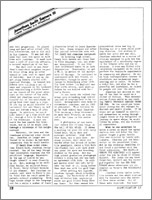
|
Page 22
was very gregarious. He played long and hard after school with his schoolmates, and he did well in his classes. It was not shyness that made him spend so much time with Jonathan. It must have been a sort of elective affinity, a natural magnetism of the two. The fact that he was Jonathan’s next-door neighbor helped. He would often drop in after school or come over to spend part of Saturday. And it was he who got young Somers started with physical therapy. He talked Mrs. Somers into building a set of bars and trapezes in the backyard and constructing a little house on the branch of the giant sycamore in the corner of the yard. Every day Jonathan would haul himself out of his wheelchair by going hand over hand up a rope. At its top he would transfer to a horizontal bar and thence up and down and across a maze of iron pipes. In addition, he would pull himself up a rope which was let through a hole in the floor of the treehouse. A seat was built for him inside the treehouse, and in it he would look through a telescope at the neighborhood. Moreover, the bars and the treehouse attracted other children. Jonathan no longer was forced to be alone; he had more companions than he could handle. If Henry Hone aided Jonathan Somers much, Jonathan reciprocated. One of the many things that interested Jonathan was the artificial language, Esperanto. By the age of twelve he had taught himself to read fluently in it. But, wishing to be verbally facile, he enlisted Henry. At first, Henry refused because of his stammer. But Jonathan insisted, and, much to Henry’s joy, he found that he could speak Esperanto without stammering. Both boys became adept in the language and for a while a number of their playmates tried to learn Esperanto, too. These dropped out after the initial enthusiasm wore out. But Henry and Jonathan continued. On entering high school, Henry took German and found that in this language, too, his stammer disappeared. It was this that determined Henry to go into linguistics. Eventually, he got a Ph.D. in Arabic at the University of Chicago. He continued to corespond with his friend, in Esperanto, though he never returned to Petersburg after 1930. His last letter (in English) was from North Africa, sent shortly before he was killed with Patton’s forces. It was Henry who talked Jonathan into attending high school instead of staying home to be tutored. Arrangements were made to accomodate Jonathan, and in 1928 he graduated. This decision to go to high school kept Jonathan from becoming a deep introvert. He made many friends; he even dated a few times in his senior year. A photograph of him taken just before his illness hangs on the wall of his study. It shows a smiling ten-year old with curly blond hair, thick dark and straight eyebrows, large dark blue eyes, and a snub nose. Another picture, shot about six months after his attack of infantile paralysis, shows a thin hollow-cheeked face with dark shadows under the eyes and brooding shadows in the eyes. But his high school graduation photograph reveals a young man who has made an agreement with life. He will not sorrow about his lot; he’ll make the best of it, doing better than most men with two good legs. After getting his diploma, Jonathan thought about attending college. The University of Chicago attracted him, especially since his good friend Henry Hone was there. But that summer his grandmother broke her hip by falling out of a tree while picking cherries. Not wishing to leave her until she was well, Jonathan embarked on a series of studies designed to give him the equivalent of a university degree in the liberal arts and one in science. A room was fitted with laboratory equipment so he could perform the requisite experiments in chemistry and physics. He also took correspondence courses in electrical and mechanical engineering and in radio. He became a radio ham, and when he had a powerful set installed, he talked to people all over the world. Jonathan had decided at the age of ten that he would be a writer of fiction. This determination firmed while he was reading Twenty Thousand Leagues Under the Sea. He too would pen tales about strong men who voyaged to distant and exotic places. If he could not go himself in electrical submarines or swing through jungle trees or fly dirigibles or journey in space ships, he would travel by proxy, via his fictional characters. When he was seventeen he wrote a novel in which the aging Captain Nemo and Robur the Conqueror fought a great battle. This was rejected by twenty publishers. Jonathan put the manuscript in the proverbial trunk. But he has recently rewritten it and found a purchaser with the first submission. The Nautilus Versus the Albatross will appear under the nom de plume of Gideon Spilett. For those who may have forgotten, Spilett was the intrepid reporter for The New York Herald whose adventures are recounted in Verne’s The Mysterious Island. Jonathan wrote twelve works (two novels and ten short stories) when he launched into the career of freelance writer. All of these were rejected. His thir- |
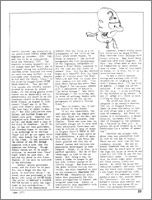
Illustration: David Haugh |
Page 23
teenth, however, was accepted by the short-lived Cosmic Adventures magazine in December 1930. Payment was to be on publication, which was February 1931. The magazine actually appeared on a few stands here and there, but it collapsed during the distribution. Jonathan never received his money nor were his letters to the publisher ever answered. However, he did sell the story, “Jinx,” to the slightly longer-lived Outré Tales magazine. This had had five issues, all chiefly distinguished by stories by Robert Blake, the mad young genius whose career was so lamentably and so mysteriously cut short in an old abandoned church in Providence, Rhode Island, on August 8, 1936. Somers’ “Jinx” was to be featured with Blake’s sixth story, “The Last Hajj of Abdul al-Hazred.” But this publication also folded, and neither Blake nor Somers were paid. Jonathan corresponded with Blake about this matter, and Blake sent a copy of his story to Jonathan. As of today, it has not been published, but Jonathan hopes to include it in an anthology he is editing. “Jinx” did not go out again until 1949, when Somers dug it up out of the trunk. It was returned by the editor of the Doc Savage magazine with a note that the magazine was folding. Though Somers claims not to be superstitious, he decided that “Jinx” might indeed be just that. He retired the story to his files. However, it too will be included in the anthology. Somers' second published story, and the first to be paid for, was a Ralph von Wau Wau piece, “A Scarletin Study.” As noted, this was published in the March 1931 issue of Outré Tales. (The editor of Fantasy & Science Fiction failed to note the copyright in his introduction.) It is evident to the Sherlockian scholar that the title is a rearrangement of the title of the first story about Holmes, “A Study in Scarlet.” The initial paragraphs are also paraphrases of the beginning paragraphs of Watson’s first story, modified to fit the time and the locale of Somers’ tale. All Wau Wau stories begin with takeoffs from the first pages of stories about the Great Detective and then the story travels towards its own ends. “The Doge Whose Barque Was Worse Than His Bight,” for instance, starts with a paraphrase of Watson’s “The Abbey Grange.” “Who Stole Stonehenge?,” the third Wau Wau in order of writing, begins with a modification of the initial paragraphs of Watson’s “Silver Blaze.” This is Somers’ way of paying tribute to the Master. Of all his characters, the most popular are the canine private eye, Ralph von Wau Wau, and the quadruplegic spaceman, John Clayter. Those who have been unfortunate enough not to have read their adventures first-hand can find an outline of many of these in Kilgore Trout’s Venus on the Half-Shell. This might serve as an introduction, a sort of appetite whetter. It was Trout who first pointed out that all of Somers’ heroes and heroines are physically handicapped in some respect. Ralph, it is true, is a perfect specimen. But he is disadvantaged in that he has no hands. And, being a dog, he needs a human colleague to get him into certain places or do certain things. Sam Minostentor, the great science fiction historian, has also remarked on this in his monumental Searchers for the Future. Minostentor attributes this propensity for disabled protagonists to Somers’ own crippled condition. Somers is consequently very empathetic with the physically limited. However, Somers seldom shows his characters as being bitter. They overcome their failings with heroic efforts. They treat their condition with much laughter. In fact, they often make as much fun of themselves as their creator does of them. Some of this humor is black, it is true, but it is nevertheless humor. “I had a choice between raving and ranting with bitter frustration or laughing at myself,” Somers said. “It was bile or bubble. I drank the latter medicine. I can’t claim any credit for this. I acted according to the dictates of my nature. Or did I? After all, there is such a thing as free will. “My stuff has often been compared to my cousin’s stories. That is, to Kilgore Trout’s. There is some similarity in that we both often take a satirical view of humanity. But Trout believes in a mechanistic, a deterministic, universe, much like that of Vonnegut’s, for instance. Me, I believe in free will. A person can pick himself up by his bootstraps — in a manner of speaking.” Jonathan was plunged into gloom when his grandmother died in 1950 at the age of ninety. There was not much time for despondency, however. She was no sooner cremated than he was informed that he would have to sell the huge old house in which he had lived all his life to pay for the inheritance taxes. To prevent this, he wrote eight short stories and three novels within six months. He saved the house but exhausted himself, and while resting his black mood returned. Then a new light brightened his life. One of his numerous correspondents was a fan, another Samantha Tincrowder. She was his mother’s cousin once removed and sister to the well-known SF author, Leo Queequeg Tincrowder. |
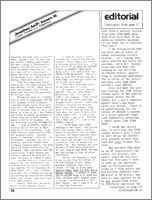
|
Page 24
Samantha had been born in New Goshen, Indiana, but, at the time she became a Somers aficionado, she was living in Indianapolis. Somers’ letters convinced her that he needed cheering up. She quit her job as a registered nurse and came to Petersburg for an extended visit. Within two months, they were married. They have been very happy ever since, the only missing element being a child. Their interests are similar, both loving books and dogs andthe quietness of village life. Though his home is a backwater, a sort of tidal pond off the main streams of the highways, Jonathan Somers quite often gets visitors. At least once a month, fans or writers drop in for a few hours or a day or so. Bob Tucker, who lives in nearby Jacksonville, often comes by to help Somers empty a bottle of whiskey. On one occasion, he even brought his own. I live in Peoria, which is within about a two and a half-hour drive of Petersburg. I go down there at least twice a year for weekend visits. Another guest is Jonathan’s relative, Leo Tincrowder. Neither Leo nor I, however, would be caught dead drinking Tucker’s brand, Jim Beam, which we claim is fit only for peasants. The subtleties and the superbities of Wild Turkey and Weller’s Special Reserve are beyond the grasp of Tucker’s taste. Jonathan Herowit stayed with Somers for six months after his release from Bellevue. (Somers has empathy for the mentally disadvantaged, too.) Eric Lindsay, an Aussie fan, stopped off during his motorcycle tour of the States after the Torcon. And there have been many others. Somers’ fans will be interested in his current project. “I plan to write a novel outside the Clayter and Wau Wau canons. It’ll take place almost a trillion years from now. It’ll be titled either Hour of Supreme Vision or Earth’s Dread Hour. Both titles are quotes from the Spoon River Anthology. The latter is from that fictitious epitaph Edgar Lee Masters wrote for my father, poor guy!” “You don’t have many years of writing left,” I said. He looked puzzled, then he smiled. “Ah, you mean Trout’s prediction that I’ll die in 1980.” He laughed. “That rascal put me in his novel just long enough to kill me off. Had a boy riding a bicycle ram into me. Well, that could happen. This town in hilly, and the kids do come down the steep streets with their brakes off. I did it myself before I got sick. But the way I feel right now, I’ll live to be eighty, anyway.” I drive away that night feeling he was right. His yellow hair has turned white, and his beard is grizzled. But he looks muscular and hairy-chested, like Hemingway when he was healthy. His gusto and delight if life and literature seem to endure his durability. His readers can look forward to many more adventures of John Clayter and Ralph von Wau Wau and perhaps a host of other characters. Somers’ old mansion is only a few blocks from the corner of 8th and Jackson Street, where Masters’ boyhood house still stands. A sign in front says: Masters Home, Open 1-5 P.M. Daily Except Monday. I wonder if someday a similar sign will stand before Jonathan Swift Somers’ home. I wouldn’t be surprised if this does happen. But I hope it’ll be a long time from now. • |
|
|
Website: The Official Philip José Farmer Home Page
• |

